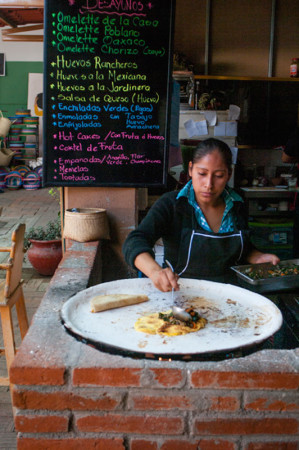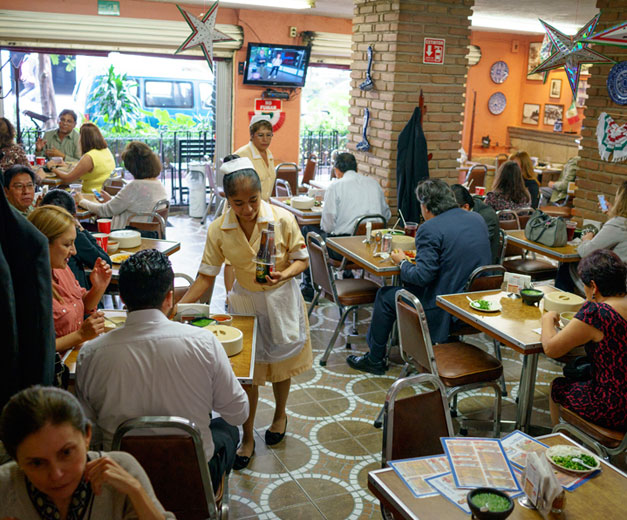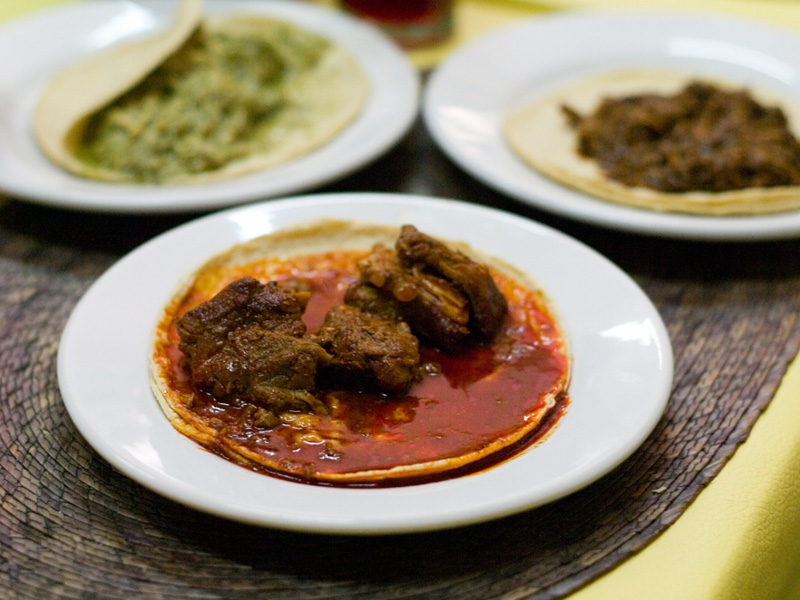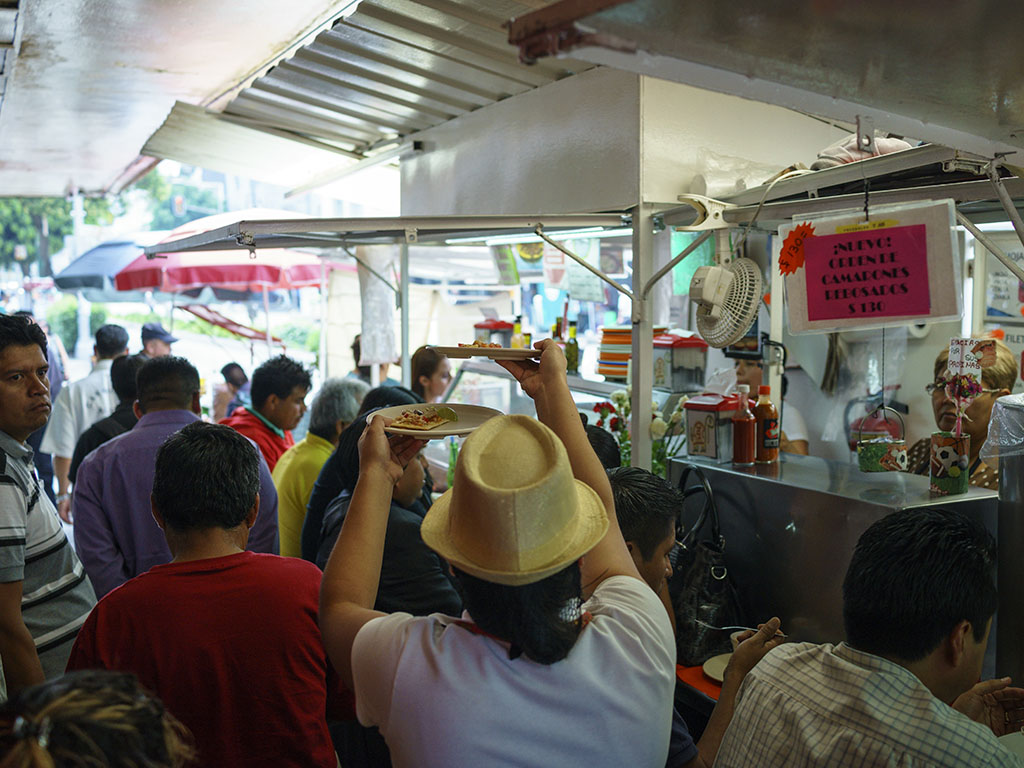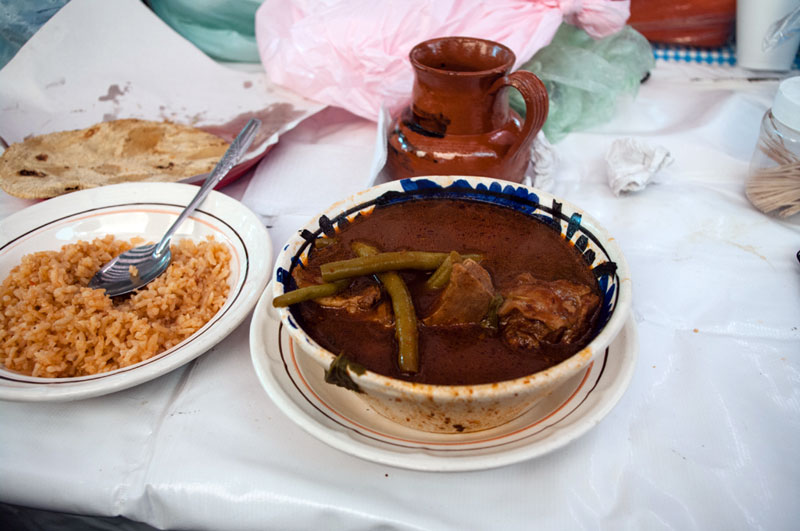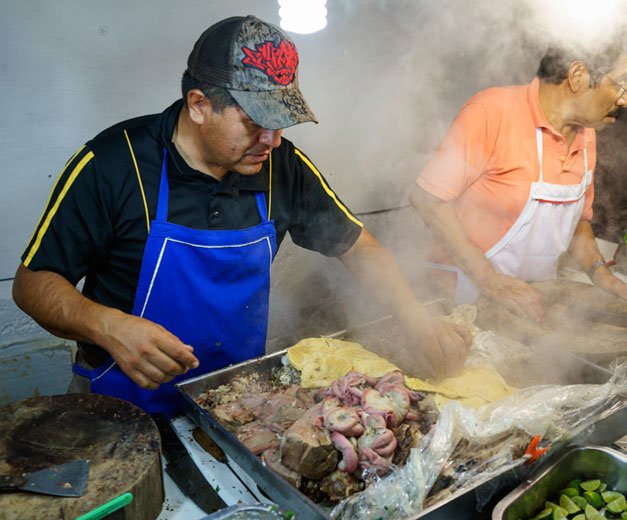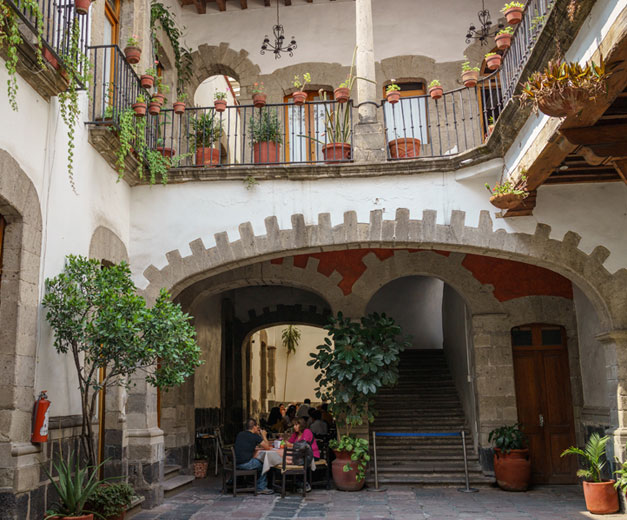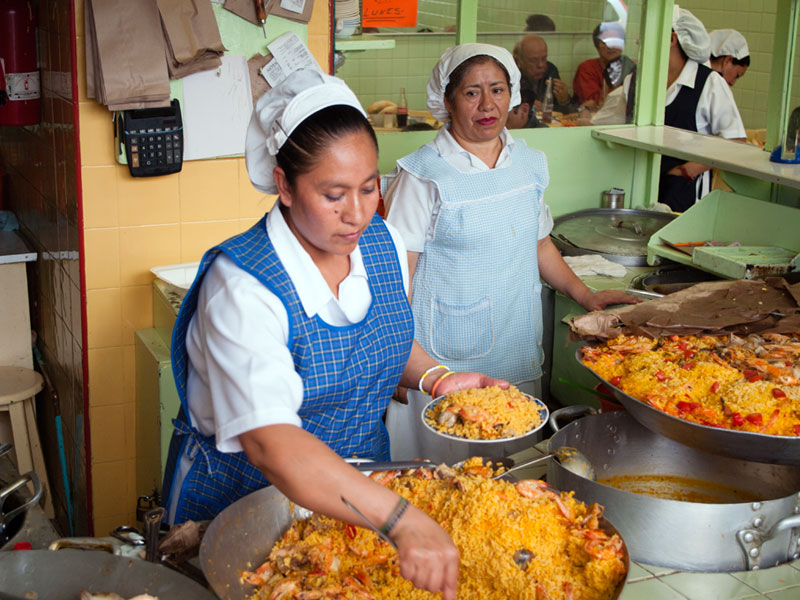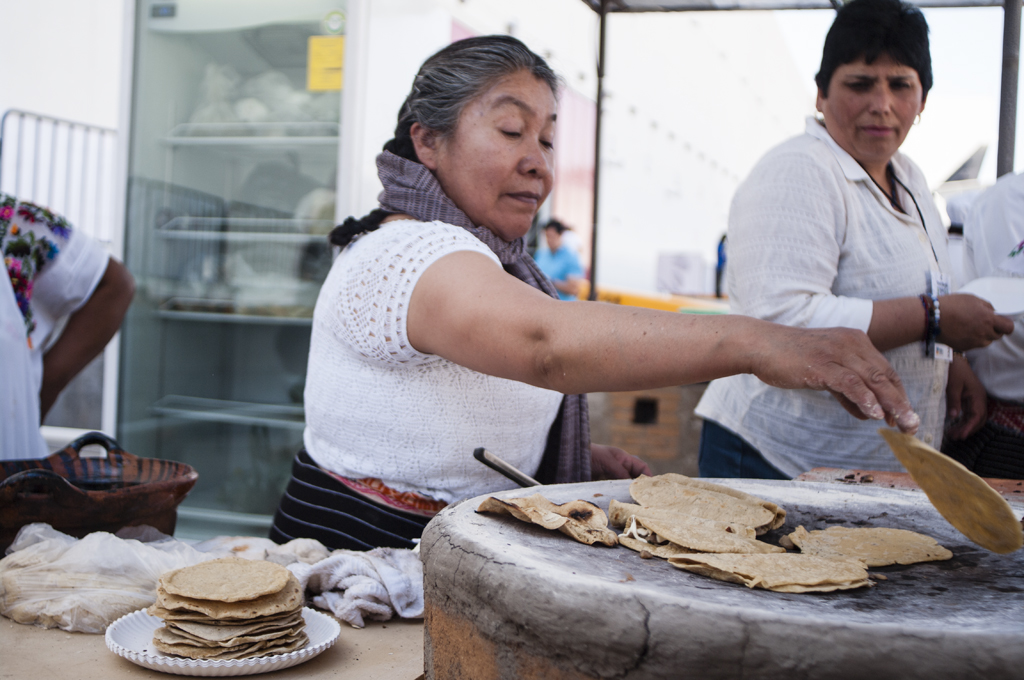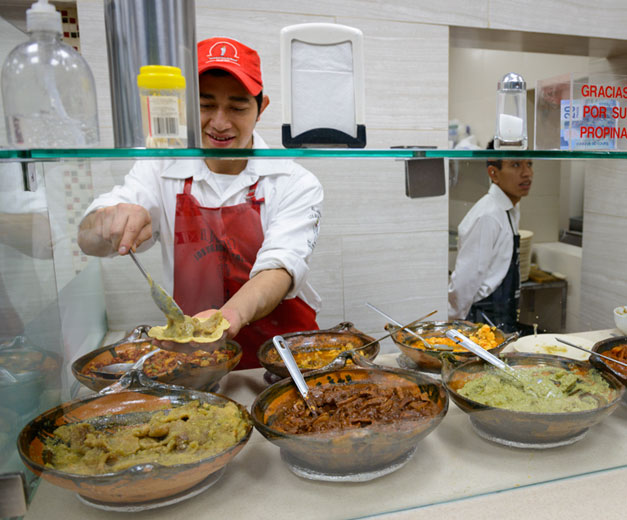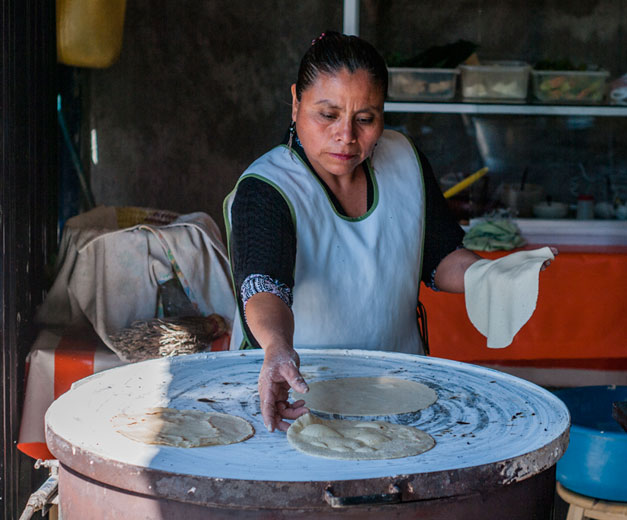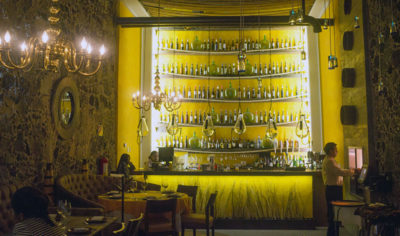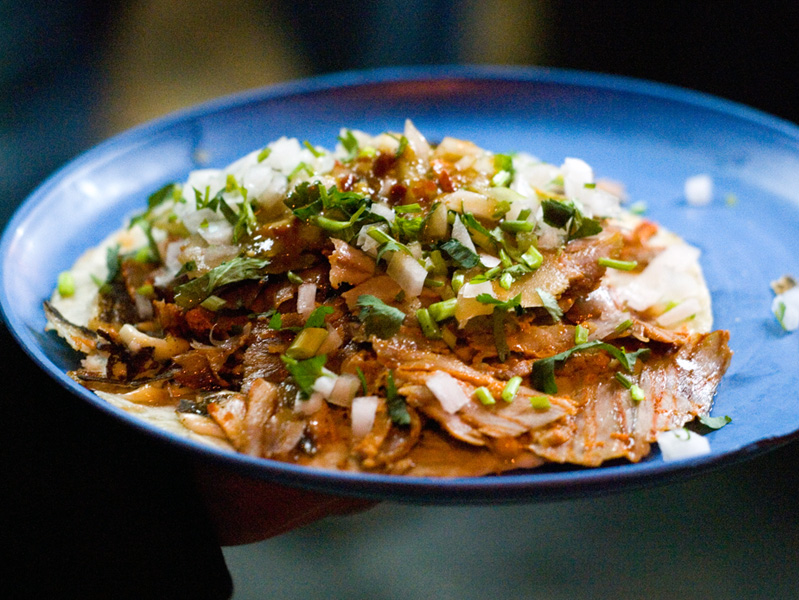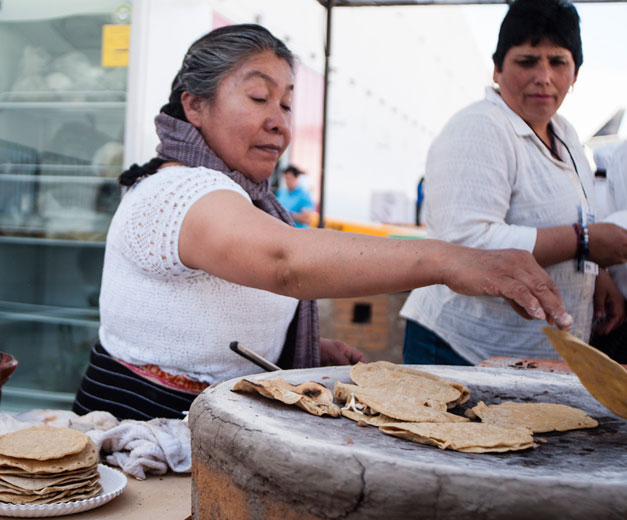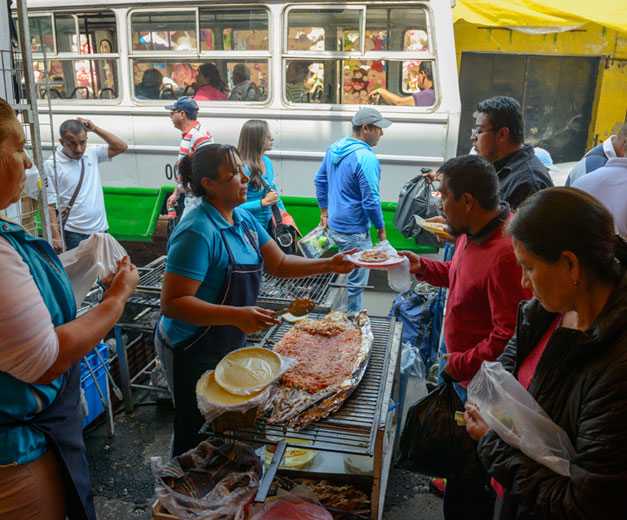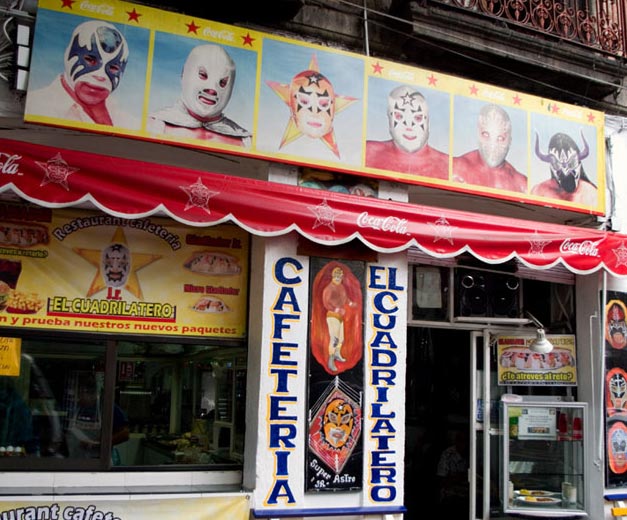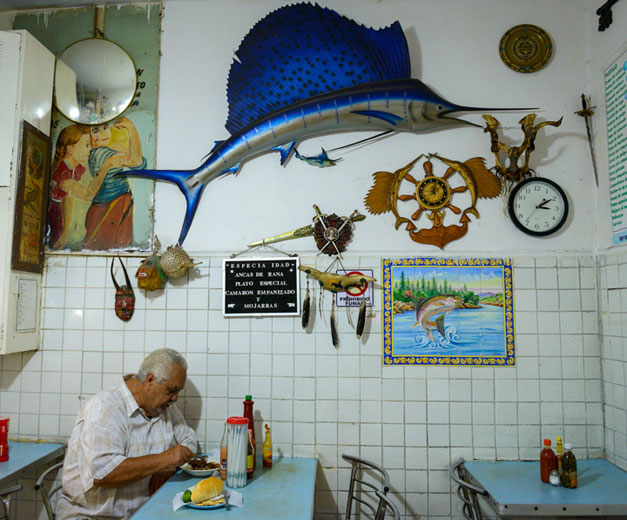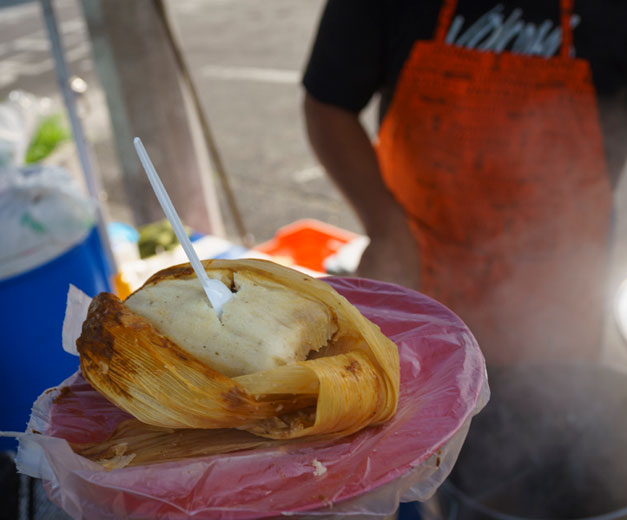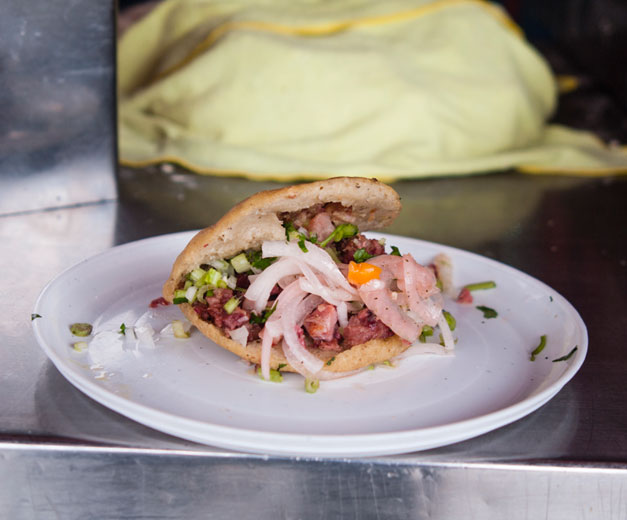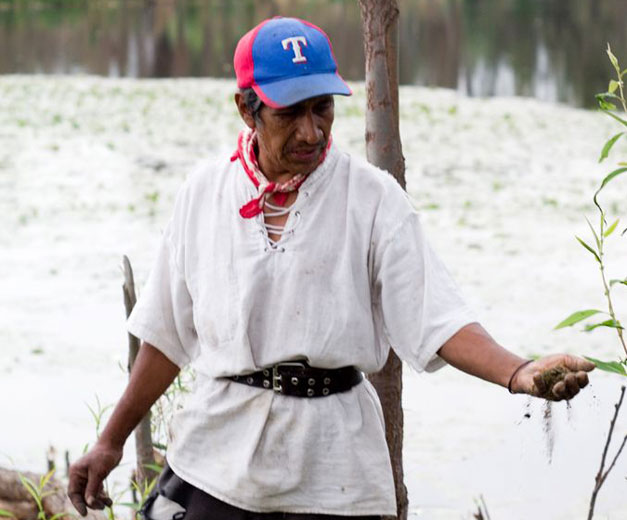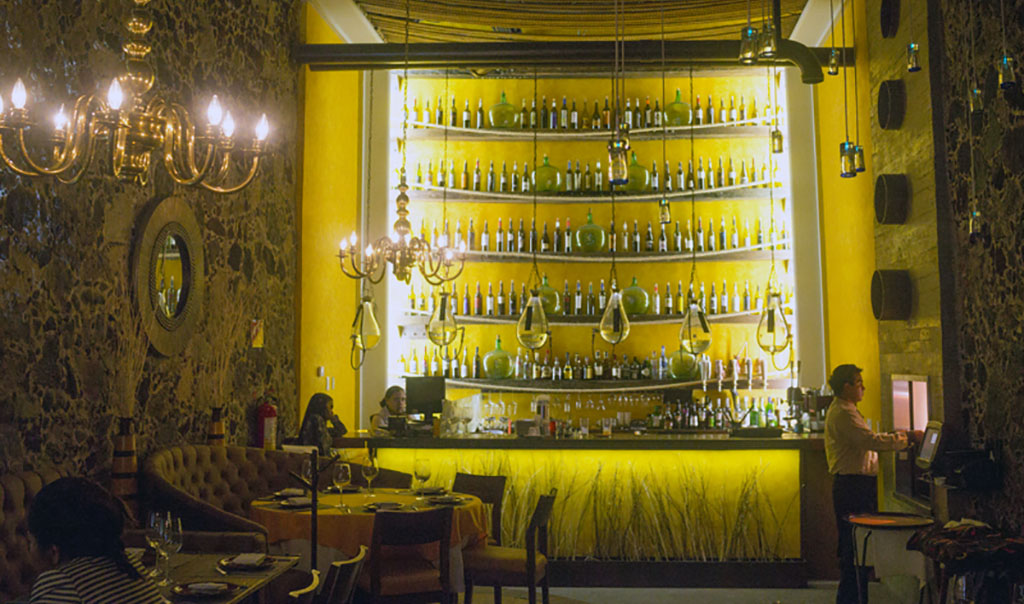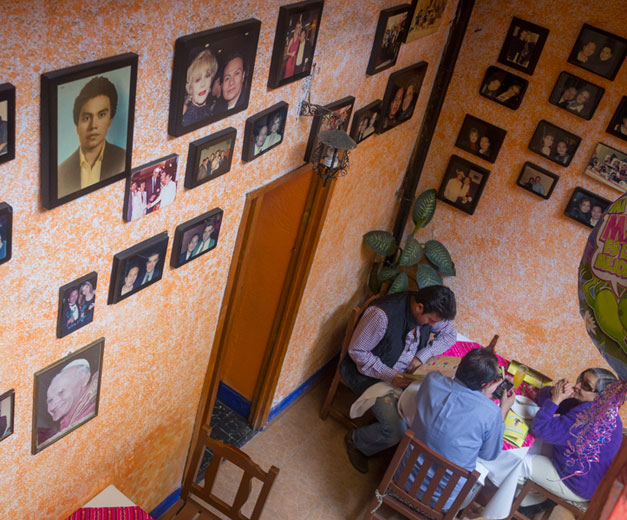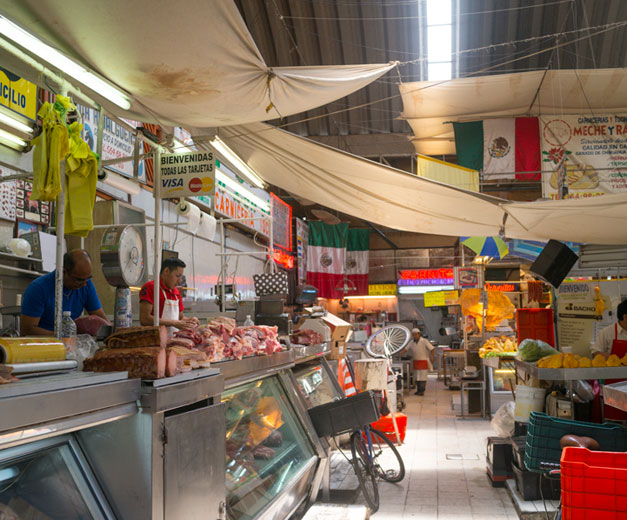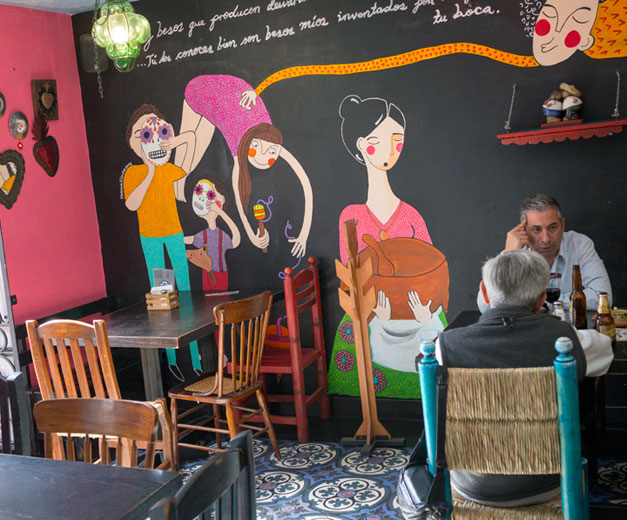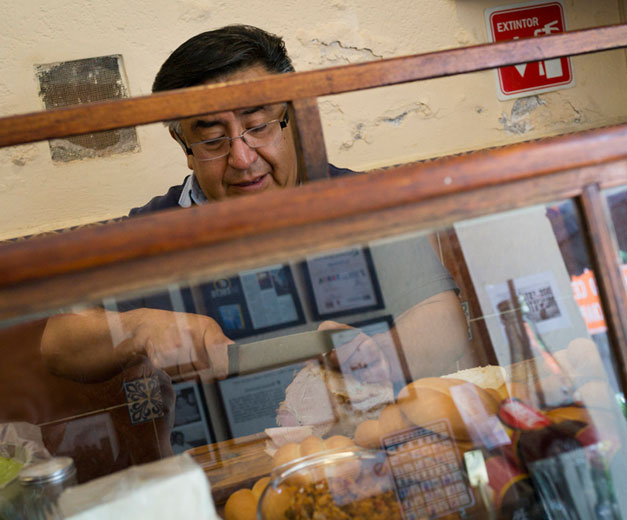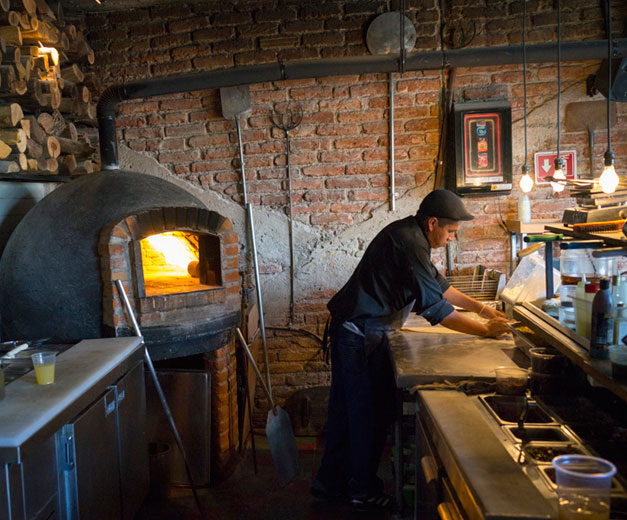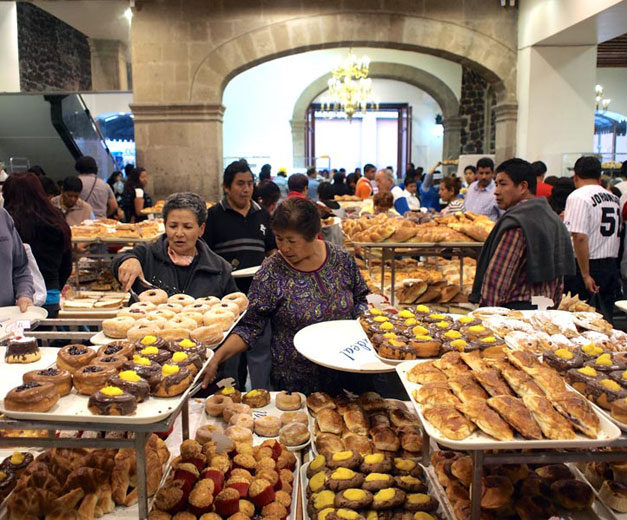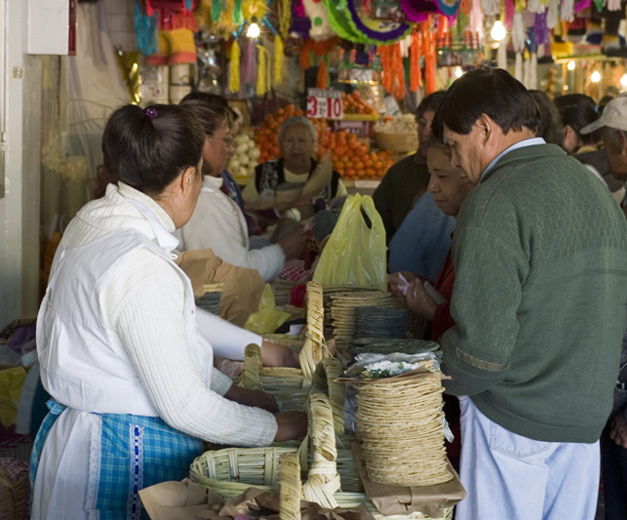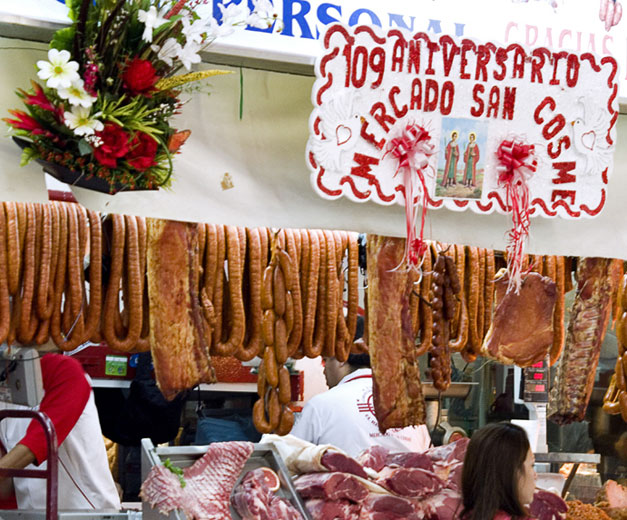We can't find the internet
Attempting to reconnect
Something went wrong!
Hang in there while we get back on track
Search results for "Ben Herrera"
Oaxaca
El Pochote: Land to Table
Oaxaca has become one of our favorite food destinations in Mexico. A few weeks ago we visited the city again, but this time it wasn’t the moles or the decadent regional food that caught our attention, but an organic market where we had a delicious breakfast one morning. El Pochote (named after a thorny, flowering tree native to Central America) is an organization of local organic producers that was founded in November 2003 by local artist Francisco Toledo. Making an omelet at Mamá Lechuga, photo by Ben HerreraThe market offers all kinds of products, from vegetables and fruits to prepared meals and juices. The main objective of the market is to support those who grow or make healthy products of excellent quality, who interact with the natural environment in a way that respects local ecosystems and who maintain and increase the fertility of the soil and land.
Read moreMexico City
El Parrillón: Gaucho Tacos
Tacos are everywhere in Mexico City, and though the options are many – chicken, al pastor, carnitas, carne asada – the basic ingredients tend to be the same wherever you go. That’s why, as we were walking the aisles of Tianguis La Raza on a Sunday morning, El Parrillón caught our attention. A big sign announced tacos – nothing new there – but besides the classic chicken and bistec, cecina and arrachera – all different cuts of beef – El Parrillón (roughly, “The Big Grill”) offers several Argentine-style sausages and cured meats, including chistorra, a small spicy sausage, and panceta, pork belly (like Italian pancetta), as well as Spanish chorizo, which, unlike the fresh Mexican sausage, is cured. But for us the real draw was griddled provolone, which we had never seen on a taco before and happens also to be one of our favorite cheeses.
Read moreMexico City
Beatricita: Taco Centenarian
In a town that runs on tacos, tacos de guisado may be the most ubiquitous version of the iconic dish in Mexico City. They can be found almost anywhere in the city, from specialty restaurants to markets, tianguis and street vendors selling them at stalls or even out of the trunk of a car. It may be an obvious point, but what distinguishes some tacos de guisado from others is how well prepared the guisados (home-style cooked meats or vegetables typically displayed and kept warm in earthenware dishes called cazuelas) are – and sometimes those coming out of the back of a car top ones from more “established” places.
Read moreMexico City
Cochinita Power: Mayan Magic
Here in Mexico City, there are many restaurantes yucatecos that serve the cooking of the Mayan states, including two of our favorites, Máare and Coox Hanal. And a few months ago, an eatery with a fresh take on Yucatecan food opened its doors in Colonia San Rafael. As its name indicates, Cochinita Power specializes in the region’s best-known dish, cochinita pibil. The traditional version consists of pork marinated in an acidic sauce made from achiote (annatto seeds) and Seville oranges, wrapped in banana leaves and roasted in an underground pit. At Cochinita Power, the meat is not roasted underground, but chef Alexis Estrada cooks the mouthwatering cochinita on the stovetop until the meat is incredibly tender and deeply imbued with all the spices and flavorings he adds to it.
Read moreMexico City
Con Sabor a Tixtla: From Guerrero, with Love
Mexican cooking is clever. With just a handful of ingredients, each region of the country has managed to create a unique cuisine that reflects local lifestyles and traditions. This fact is made abundantly and deliciously clear at Con Sabor a Tixtla, a small, family-owned restaurant in Mexico City’s hip, vibrant Roma neighborhood. Located on a quiet street not far from Mercado Medellín, the restaurant specializes in food from Guerrero, a southwestern state – home to the famous resort town of Acapulco – known for its seafood and its green pozole, a meat and hominy stew that is one of Mexico’s most iconic dishes.
Read moreMexico City
Fonda Mi Lupita: Holy Mole
We’ve written about mole before, but it’s possible that there aren’t enough words to spill on such a complex dish – probably the most complex in all of Mexican cuisine. Mole has become part of the mainstream culinary scene in Mexico, and many restaurants now sell it every day of the year. However, very few places are mole-only eateries, and even fewer have a mole great enough to have sustained business for decades. One of our favorite eateries, Fonda Mi Lupita, a small fonda in the Centro Histórico that started making mole in 1957, holds that rare distinction.
Read moreMexico City
Ask CB: What Are Aguas Frescas?
Dear Culinary Backstreets, I’ve heard about drinks in Mexico called “aguas frescas,” but what exactly are they? Visitors to Mexico are sure to encounter aguas frescas, a popular category of drinks that are ubiquitous at food stands and eateries around the country. These colorful beverages, whose name literally means “fresh waters,” come in a variety of different flavors depending on the main ingredient, but generally all are made by mixing a fruit juice with water and sugar.
Read moreMexico City
Café de Raíz: Veracruz in the D.F.
The cuisine of Mexico City has long been influenced not only by waves of international immigrants but also by regional cooking from around the country. In the mid-20th century particularly, droves of workers and their families, lured by economic opportunities, arrived in the Distrito Federal from every corner of Mexico, bringing their local customs and food traditions with them and greatly enriching both the city’s culture and its culinary scene.
Read moreMexico City
Marisquería El Caguamo: Downtown Seafood Paradise
A foodie friend of ours took us to El Caguamo – aka K-guamo – for the first time a few years ago, promising us that this was the best marisquería (seafood restaurant) in the city. And since then, it has become one of our favorite downtown stops. For almost 40 years, the Tamariz family has been selling tasty shellfish and seafood on the sidewalk of Ayuntamiento Street, just a couple of blocks away from San Juan market in the heart of Mexico City.
Read moreMexico City
Señora Ema: The Wild Brunch
Update: This spot is sadly no longer open. The tianguis, or street market, has been an essential part of Mexican culture since pre-Hispanic times. In Mexico City, every neighborhood has at least one weekly tianguis, most selling produce, fish, meat and household goods, so families can buy all they need for the week in a single place. All of these markets, large or small, have one thing in common: an abundance of street food stands. Many of these vendors move around the city with the markets, and some have become so well-loved that neighborhood residents eagerly await the day of their local tianguis so they can enjoy tasty food served streetside.
Read moreMexico City
Best Buzz: Mexico City's Top 5 Coffee Shops
Like other cities around the world, Mexico City has been flooded with big-name chain coffee shops that charge exorbitant prices for a cup of bad coffee. Fortunately, D.F. is a city of contrasts, where good taste in coffee still exists. We set out to find the best coffee shops in town and were surprised by what we found. Our first stop was one coffee shop we have been visiting for several years now, Café Triana, inside Mercado San Juan, the city’s first gourmet stop par excellence. Marilu and Pablo Arana started selling coffee from Veracruz, a city on the Gulf of Mexico with a Caribbean feel, in the aisles of the market until they got the chance to get a booth and start their own coffee shop. Their establishment has since been featured in many national and international media outlets.
Read moreMexico City
Tacos Lolita: Head Case
As with so many of the world’s great cuisines, Mexican cooking makes the most of every part of the animal, and for many of us culinary adventurers, beef cabeza, or head, is the source of some of the tastiest meat you can find in a tortilla. We’d been on the lookout for the best tacos de cabeza in the city, and we think we’ve finally found them.
Read moreMexico City
San Francisco: Dining Across State Lines
Update: This spot is sadly no longer open. True to its name, Mexico City’s Centro Histórico is full of history everywhere you look. Walking its cobblestone streets guarded by historic buildings, some 500 years old, is always a great learning experience for us. On one of our recent walks through this amazing part of the city, we stumbled upon one building that caught our attention. First of all, there was a sign at the entrance that said that José Martí, Cuban poet, writer, philosopher and revolutionary leader, lived in the building at the end of the 19th century.
Read moreMexico City
Los Parados de Don Pepe: Taco Grande
In our recent explorations of Mexico City’s Azcapotzalco neighborhood, we were taken to a taquería that was going to “blow our minds,” according to our host. After having some drinks at El Dux de Venecia, the oldest surviving cantina in the city, we headed around the corner to Los Parados de Pepe for a visit.
Read moreMexico City
Gran Cocina Mi Fonda: Blessed Are the Paella Makers
In recent years, downtown Mexico City’s once grimy Centro Histórico has undergone a remarkable transformation. The government and private enterprises have invested in new infrastructure, pedestrian walkways, parks, hotels and high-end apartment buildings that give the area the look and feel of a district that is part of a modern, dynamic capital city.
Read moreMexico City
CB on the Road: The Seven Moles of Oaxaca
The word mole comes from the Nahuatl molli, which means “mixture,” and is used to refer to a number of sauces prepared all over Mexico. There’s some controversy as to which spot is the birthplace of mole (Puebla, Tlaxcala and Oaxaca all claim the prize) and when exactly these sauces were created. What we do know about mole sauces, however, is that they are the perfect culinary example of the mestizaje that took place in Mexico after the arrival of the Spanish conquistadores. They combine native ingredients such as chilies, fruits and seeds with elements brought by the newcomers, including nuts, exotic fruits and even bread.
Read moreMexico City
CB on the Road: The Best of Puebla Under One Roof
Among the regions of Mexico that are best known for their culinary wealth, Puebla is near the top. Approximately 100 kilometers east of Mexico City, Puebla is the birthplace of chiles en nogada, mole poblano (probably the most recognized Mexican mole worldwide) and cemitas, a knockout sandwich made with the bread of the same name.
Read moreMexico City
Tamales: Good Things in (Mostly) Small Packages
As we mentioned in our piece about Rosca de Reyes, February 2 is an important date in the Mexican calendar - for Candlemas and, relatedly, for tamales. True, tamales are one of the most popular foods in Mexico City, and we can find all kinds of reasons for eating them any day of the week. But this day commemorates a ritual visit Mary made to the temple in Jerusalem with the baby Jesus. In the Catholic Church and Orthodox traditions, February 2 is the Feast of the Presentation of the Lord, and at one time, the candles used in services in church throughout the year would be blessed that day, hence the name Candlemas or Candelaria. Native Mexicans would celebrate the planting this time of year with a big feast that would include tamales, and the indigenous and Christian traditions became linked.
Read moreMexico City
Taquería El Jarocho: All Filler
There’s something limitless about tacos in Mexico. All you need for a good taco is a soft corn tortilla – handmade are a plus – and a filling, which can take the form of meats such as al pastor, carnitas, mixiote, fish, vegetables and, lesser-known outside of Mexico, guisados.
Read moreOaxaca
Eating Oaxaca: A Visit to Mexico's Culinary Mecca
We’ve written previously about the immense diversity of Mexican cooking: Every region has unique traditions that build upon ingredients common to much of the country. And yet there are a few regions that stand out for the variety and vividness of the flavors, colors and tastes found there.
Read moreMexico City
Best Bites of 2014: Mexico City
Editor’s note: The year is coming to an end, which means it’s time for us to look back on all the great eating experiences we had in 2014 and name our favorites among them. Tacos el Patán This hole-in-the-wall eatery is located in one of the busiest commercial sections of downtown Mexico City. We found it one day while we were shopping for stuffed animals and have since returned several times. El Patán is open every day but only serves fish tacos, the best item on their menu, on Wednesdays, Fridays and Saturdays. Those days they also offer skewered shrimp and deep-fried fish quesadillas made with the same fish as that used in the tacos. The rest of the week, the taquería prepares cecina (salted beef), chicken, suadero (brisket), al pastor and longaniza (a type of sausage) tacos. But the fish taco – made from barracuda, no less – was the best of its kind that we had this year.
Read moreMexico City
Preservation Society: Safeguarding Mexican Gastronomy in Puebla
In November, the Conservatorio de la Cultura Gastronómica Mexicana held its second International Mexican Gastronomy Forum in the city of Puebla, about 100 kilometers east of Mexico City. We had the opportunity to attend and learn more about the importance of creating this kind of space to preserve and propagate Mexican recipes that have been cooked for thousands of years.
Read moreMexico City
La Dulcería de Celaya: Sweets Central
Mexican sweets might not be as world-famous as those from the U.S., France or Switzerland, but judging by the enormous variety of pastry, candy and chocolate made and consumed domestically, Mexicans have an insatiable sweet tooth. And chocolate, of course, is one of Mexico’s gifts to the world.
Read moreMexico City
Tacos El Patán: Love at First Bite
There’s more to downtown D.F. than tourist attractions, however. It is the cultural, political and economic heart of the city and the country. Any item imaginable can be bought downtown. There’s the lighting district as well as one for appliances, clothing, electronics, printing and a long list of others. For generations, people have been going there to buy by the piece or wholesale to supply small businesses all over the country.
Read moreMexico City
Cafetería El Cuadrilátero: Torta (and Wrestle) Mania
Editor's Note: Sadly, this spot is now closed. Mexico City’s Centro Histórico is never a dull place. Combined with the massive crowds and the constant roar of honking horns, passing buses and shouting vendors, the sheer visual stimulus is enough to make one weak in the knees after an hour or so. It can be a huge relief to step off the street for a breather and a bite to eat – although, in the case of Cafetería El Cuadrilátero, whose name can be translated to “wrestling ring cafeteria,” a “bite” is quite an understatement.
Read moreMexico City
Merendero Las Lupitas: North Star
In the U.S., chimichangas and burritos are always associated with Mexican food, but in the central part of Mexico those words don’t mean a lot. In Mexico City, specifically, it’s very hard to find burritos that resemble those found north of the border, and the word “chimichanga” doesn’t even exist in our vocabulary.
Read moreMexico City
Mariscos Frescos del Mar: Hoppin' Good
When it comes to finding new places to eat in Mexico City, we’ve learned not to be too quick to judge a place by its looks. A very good example of this is Mariscos Frescos del Mar, a hole in the wall we had passed without noticing many times before. When a good friend recommended it, we couldn’t even place it on a map, though we know the street it’s on very well.
Read moreMexico City
CB on the Road: The Magical Mining Towns of Hidalgo
A few weeks ago we wanted to get out of bustling Mexico City, but we only had one day free, so we decided to look for a place where we could see some sights, eat, enjoy ourselves and still be back before the day was over. We found not just one, but two gorgeous towns that fit the bill in the state of Hidalgo, just over an hour north of Mexico City. The picturesque town of Real del Monte, also known as Mineral del Monte, is a small pueblo mágico (the Ministry of Tourism’s designation for a unique and historically significant village) with a long and rich heritage. It was one of the first mining towns the Spanish established after La Conquista. Much of the silver and gold mined during the colonial and post-colonial periods came from this part of the country.
Read moreMexico City
Papalotl: Vegetarians, Rejoice!
The first inhabitants of what is modern-day Mexico City subsisted on mostly plants and grains. Their daily protein intake came from nixtamalized corn, beans, insects and, in smaller amounts, fish and game. When the Spanish brought pork, chicken and cattle to the New World, the local diet changed forever.
Read moreMexico City
Tacos de Canasta La Abuela: Basket Case
Just a block away from Mexico City’s financial district, one unlikely food star sets up shop every morning. From Monday to Saturday, at La Abuela, 72-year-old Arnulfo Serafin Hernandéz feeds hungry office workers, commuters, neighbors, school kids, government officials and tourists from all over the world with one of the simplest Mexican dishes: tacos de canasta.
Read moreMexico City
Tamales Los Vaporcitos: Full Steam Ahead
On our list of favorite Mexican comfort foods, the tamal would likely come in near the top. Simple, yet extremely versatile, tamales share pre-Hispanic roots with the tortilla. A corn masa very similar to the kind created during the nixtamalization process to make tortillas is used as the base for delicious tamales. Recently, we found a first-rate version of this ancient food from a new street vendor located just blocks from the Monumento a la Revolución.
Read moreMexico City
CB on the Road: Taxco, Pueblo Mágico
In Mexico, magic is all around us. It’s in the architecture, history, way of life – and, of course, the food. The country’s Ministry of Tourism is no stranger to this magic, and in fact, fully grasping its economic possibilities, it created the Pueblos Mágicos program in 2001 to recognize villages that are unique and historically significant. There are now 80 such pueblos mágicos across the country, and one of our favorites is just a short drive away from Mexico City.
Read moreMexico City
Taquería La Única: Snout to Tail
Carnitas, a pork dish that originated in the state of Michoacán, can be found in restaurants, markets and street stalls all over Mexico City – it’s a fixture of the chilango diet. The other day, we received an invitation to visit a carnitas place that our host said would blow our minds – and that’s definitely the kind of offer we never refuse.
Read moreMexico City
Los Machetes Amparito: A Cut Above the Rest
If you think you know quesadillas, think again. Since 1964, the Montoya family has been preparing a version that defies the concept, even by Mexican standards. We were told that in the Guerrero neighborhood – undeservedly considered a rough area – we would find a quesadilla so large that just one would be enough to feed two people. We consider ourselves good eaters, so we took this as a challenge.
Read moreMexico City
Xochimilco's Chinampas: Ground Work
Several weeks ago, we visited the ecological reserve of Xochimilco to meet some of the people who are trying to make a difference in food production in Mexico City. Aboard a colorful trajinera, or boat, we enjoyed a delicious salad made with local produce, as well as chicharrón, guacamole and locally produced cheese while Ricardo Rodriguez, owner of De La Chinampa, explained to us what the project is all about. “We’re trying to connect producers with consumers. What we do is bring the food from the soil to the table, always making sure the small and local producers benefit from this trade and keeping in mind where the food comes from and its history. Our main goal is the ecological restoration of the zone through the commercialization of the local products.”
Read moreMexico City
Los Limosneros: Instant Classic
Juan Pablo Ballesteros comes from a family of entrepreneurs. In 1912, his great-grandfather, Rafael Ballesteros, opened Café Tacuba, which is today a food landmark in Mexico City’s Centro Histórico. Not far from this culinary treasure is Los Limosneros, which Juan Pablo opened more than a year ago, seeking to continue his family’s legacy while building a reputation of his own.
Read moreMexico City
Oaxaca en Mexico: The Mole Family
Oaxaca, in southwestern Mexico, is one of the country’s most biologically and culturally diverse states, with its Pacific coastline and confluence of mountain ranges at a tropical latitude and the numerous indigenous groups that have populated the area for centuries – or longer. All of these influences have produced a regional cuisine that is incredibly rich and deep and beloved among food-loving Mexicans (and non-Mexicans). Many immigrants from Oaxaca have brought this diversity of food and culture to Mexico City.
Read moreMexico City
Mercado de Medellín: Smiles (and Provisions) by the Kilo
In Mexico, marketplaces have been the soul of communities for millennia, and of the many modern-day ones we’ve visited in Mexico City, the one we’re always most excited to return to is Mercado Medellín in Roma Sur. Recently, we visited with a guide, an American expat who gets her produce and meat there every week and could get us the inside scoop. Our first stop was La Sorpresa butchery. Arturo, the owner, shook our hands and continued breaking down a large piece of beef for a special delivery. He told us that his family has run La Sorpresa inside the market for 25 years. The meat they sell comes from different slaughterhouses in the country, and even from the United States.
Read moreMexico City
El Beso Huasteco: Eastern Promises
Editor's Note: Sadly, this spot is now closed. La Huasteca, a region in Mexico that extends through several eastern states, including San Luis Potosí, Veracruz, Tamaulipas, Hidalgo, Querétaro and Puebla, gets its name from the pre-Hispanic civilization that inhabited the area. There are still some indigenous Huastec communities that live in the region, and like those of the rest of the country, their local food and customs have been highly influenced by the Spanish conquest and the influx of immigrants both domestic and international.
Read moreMexico City
Best Thing Since Sliced Bread: Mexico City's Top 5 Torterías
Taquerías are probably the most common kind of eatery in Mexico City, but torterías, purveyors of tortas, the generously filled sandwiches that come on bolillo rolls or the smaller teleras, are not far behind. From stalls at subway station exits to restaurants that have been in business close to a century, torterías are a fixture in the city landscape. Here are five of our favorites, in no particular order:
Read moreMexico City
A Slice of the Action: Pizza in Mexico City
Mexico City is indisputably one of the world’s great eating capitals, and one of its main draws is the astonishing regional diversity in the Mexican cuisines that are available here. But sometimes, the only thing that’ll hit the spot is a slice of pizza. Fortunately, D.F.’s got you covered there, too. There are hundreds of pizzerias to choose from, from big chains to small family-run establishments, but these are our three favorites.
Read moreMexico City
CB on the Road: Sun and Seafood in Acapulco
Acapulco, the famed resort town of the state of Guerrero, on the Pacific side of Mexico, has been the most popular getaway destination for chilangos (slang for Mexico City residents) for generations. The proximity of this beautiful bay to the capital – it’s just a four-hour drive or 45-minute flight – makes it easy for us to spend a long weekend there partying, swimming in the ocean or just soaking up rays on the white sand beaches and doing a whole lot of nothing. While Acapulco has gotten a bad rap in recent years for drug-related crime and violence, it’s still quite safe for tourists.
Read moreMexico City
Mezcalerías: Where There's Smoke
Editor's note: For our last stop on CB's Global Bar Crawl this week, we're pulling up a stool at our favorite mezcal bars in Mexico City, kicking back and savoring every last drop. Para todo mal, mezcal. Para todo bien, también. Y si no tiene remedio, tómate litro y medio. For everything bad, mezcal. For everything good, the same. And if that doesn’t help, drink a liter and a half. – Popular saying among mezcal lovers.
Read moreMexico City
La Casa de las Enchiladas: Get Sauced
Fried tortillas, stuffed and sauced: enchiladas are simple in concept, but they come in a seemingly endless variety, depending on region and ingredients. The tortillas might be made of corn or wheat flour, and they could be stuffed with all manner of meat or vegetables (or both), but the sauce – or salsa – is really what it all comes down to.
Read moreMexico City
Rise and Shine: A Mexico City Breakfast Primer
Editor's note: It's Breakfast Week at CB, and the second piece in the series takes us to Mexico City for a look at typical morning meals and the best places to find them. Stay tuned for more breakfast dispatches from other CB cities throughout the week. Mexico leads the world in per capita egg consumption, according to the country’s National Poultry Institute. That’s not hard to believe if you’ve ever taken a look at a typical Mexican breakfast; in homes and at restaurants huevos are the first order of the day for many a desayuno. And with all those eggs they eat, Mexicans have come up with a number of ways to dress them up or down. One of the most popular ways to prepare them, for example, is huevos revueltos al gusto, two or three scrambled eggs with an additional ingredient or ingredients, such as ham, chorizo, sausage, vegetables or a la mexicana (onion, chilis and tomato). Huevos can also come divorciados, which are two sunny-side-up eggs, one bathed in green salsa and the other in red; rancheros, or fried and served over corn tortillas and refried beans and bathed in a red or green salsa; al albañil, scrambled and served with a very hot red salsa and fresh cheese; or ahogados, poached in green or red salsa. Most of these egg dishes are served with a side of refried beans, avocado and corn tortillas.
Read moreMexico City
Mercado Xochimilco: Get Off the Boat
One of our favorite places in Mexico City is Xochimilco. Like many visitors, when we hear the word “Xochimilco” the first thing that comes to our mind is a relaxing ride aboard a trajinera, or boat, on the waterways of this southern borough. We’ve been to Xochimilco many times before, on family excursions to buy flowers, plants and compost from the local farmers.
Read moreMexico City
Best Bites of 2013: Mexico City
Editor’s note: This post is the fourth installment of “Best Bites of 2013,” a roundup of our top culinary experiences over the last year. Stay tuned for “Best Bites” from all of the cities Culinary Backstreets covers. Hilaria Gastrobar We visited this restaurant on revitalized Madero Street downtown just a few months after it opened, and we were immediately won over by the food and beer selection.
Read moreMexico City
La Casona del Sabor: School Lunch
Once considered Mexico City’s next hot neighborhood, Santa María la Ribera, near the city's center and one of its first suburbs, has been slow to deliver on that promise. While neighborhoods just to the south have stolen Santa María’s thunder, it’s finally showing signs of life – one of which is the restaurant/cooking school La Casona del Sabor. Built 140 years ago by a German immigrant couple, the building that houses La Casona features traditional colonial architecture, including a grand entrance that leads into a spacious, landscaped courtyard. Looking out over the courtyard is a colorfully tiled verandah that connects to multiple rooms. Once family quarters, these rooms now serve the culinary school. The school's head chef, Jorge Luiz Alvarez, began the school seven years ago in his nearby apartment, but when space became tight, he took over the house and expanded the business.
Read moreMexico City
Mercado San Cosme: Treasure Trove
Whenever we explore a neighborhood in the city, we look for the tianguis: local markets that serve as a very important part of life in Mexico. Almost everything needed for a household can be found in their narrow and colorful aisles. Mercado San Cosme is the tianguis in Colonia San Rafael, a beautiful and charming neighborhood that was established in the late 19th century as one of the first formal communities outside of the city center. In the Porfirio Díaz era, San Rafael catered to the wealthy, and the beautiful buildings and façades that still grace the streets there speak to those long-ago days of glory.
Read more